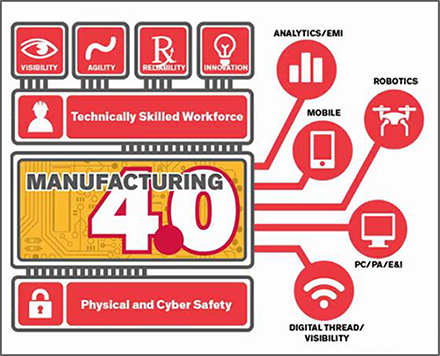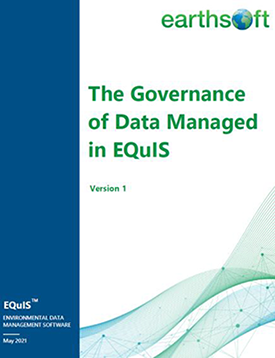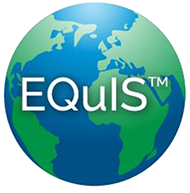
Evolution of Industry
![]()
Scholars agree that there have been four industrial revolutions.
![]()
The first was brought about by the mechanization and introduction of water and steam power in the late 1700s and early 1800s.
![]()
The second revolution came about through use of mass production and assembly lines using electrical power sources in the mid-1800s.
![]()
In the 1900s, the introduction of automated production using computers, robotics, and IT systems is thought of as the third industrial revolution.
![]()
In the 2000s, the introduction of “smart factories” with autonomous systems, Internet of Things (IoT), and machine learning are part of the fourth industrial revolution, known as Industry 4.0.

Industry 4.0 and the Smart Factory
![]()
As the end of the first quarter of the 21st century approaches, many economic and environmental challenges confront modern industry. Continued adaption to new and emerging technologies is an ongoing reality, which has driven the Industry 4.0 revolution and emergence of smart factories. Also known as digital manufacturing and cloud-based manufacturing (CBM), the smart factory offers:
- Cloud computing
- Automation
- Smart sensors
- Big data
- Artificial Intelligence (AI)
- Predictive maintenance
- Advanced algorithms
- IoT
- Sensor fusion

EDMS and Industry 4.0
![]()
How does the Industry 4.0 revolution impact the environmental management sector in an industrial setting? Data generation (and the use of it) is at the core of every decision made by every environmental department. Key issues surrounding data are:
- How do we gather it?
- How do we organize it?
- Can we trust it?
- How do we use it?
An Environmental Data Management System (EDMS) is used to solve these fundamental issues. The modern EDMS is versatile and robust and used to manage all data sets associated with environmental programs. An EDMS is part of an overall corporate data governance program and supports management of program-and project-specific workflows that are often complex, involving multiple stakeholders, multiple disciplines, and multiple regulatory requirements.
![]()
An EDMS user understands that:
- To make good decisions, I need good data;
- I need a “source of truth”; and
- Business processes and procedures must be enforced to ensure good quality (i.e., truth).
The EDMS supports the goals of Industry 4.0 and brings added value using smart processes to provide sound and reliable data. An investment in digital process quality is key.


Manufacturing 4.0 Initiative
![]()
Dow Chemical recognizes the synergy between their Manufacturing 4.0 initiative and the EDMS associated with their environmental remediation portfolio. Dow uses EarthSoft’s EQuIS™ as their EDMS and as part of their corporate data governance program. EQuIS is the world’s most widely used environmental data management system and efficiently manages data for thousands of organizations. EarthSoft also supports Dow (and other clients) by providing guidance on how to incorporate EQuIS in their data governance program.
Elements of Dow’s Manufacturing 4.0 initiative related to their EDMS are:
- Digital Thread and Visibility – EDMS provides a centralize database source with dashboard views.
- Analytics – EDMS allows Dow to analyze, view, and report against regulatory standards and internal processes.
- Mobile – EDMS comes with mobile applications for data collection and processing.

Data Governance and Management
Data are a business asset that must be protected and managed. Data governance functions to guide data management activities and ensure that data are properly managed. A data governance program provides the authority and control (planning, monitoring, and enforcement) over the management of the company’s data assets.
The overall goal of data governance is to enable an organization to manage data as an asset. To achieve this main goal, the data governance program needs to be sustainable beyond initial implementation and adaptive to change. The data governance program should be incorporated throughout the data workflow from project planning to data analysis.
Dow’s Business Objectives and Data Governance
![]()
Standardize Workflow across Dow Portfolio
- Data standards that are linked to key steps in the workflow.
- Well-defined and clear responsibilities that ensure employees are consulted, informed, and understand who is responsible and accountable.
- Allow data merging from EQuIS and non-EQuIS users.
Improved Communications
- Cascading information from Dow’s Data Management, Dow RLs, their consultants, and their partner Labs.
- Electronic data deliverables and reference value changes.
- EQuIS dashboard with latest standards.
Specific Remediation Portfolio Objectives
- Decrease costs across entire portfolio – Maximize automation of data collection and processing, clearly define consultant expectations and responsibilities, and facilitate data analysis.
- Minimize risk – Enforce quality, ensure defensibility, and dictate content expectations.
- Leverage investment in environmental data management and historical data migrations – A data governance and master data management plan allows for integration of data across the business (e.g., financial, health and safety systems). Consistent data across remediation portfolio are a prerequisite for descriptive and predictive analytics.
Industry 4.0 Goal Achievements for Dow
![]() Cloud Computing – EDMS (EQuIS) in the cloud
Cloud Computing – EDMS (EQuIS) in the cloud
![]() Big Data – Global access by 138 active facilities
Big Data – Global access by 138 active facilities
![]() Automation – Automated environmental data workflows
Automation – Automated environmental data workflows
![]() IoT, Smart Sensors – Data loggers and field sensors
IoT, Smart Sensors – Data loggers and field sensors
integration
![]() Predictive Maintenance – Operation and Maintenance data to direct support tasks
Predictive Maintenance – Operation and Maintenance data to direct support tasks
![]() Advanced Algorithms – Advanced analytics for calculation, visualization, and reporting
Advanced Algorithms – Advanced analytics for calculation, visualization, and reporting
Saved $250,000 and growing from just one part of the program.

EarthSoft and EQuIS
![]()
EarthSoft is the recognized leader in providing environmental and geotechnical data management and decision support systems for industrial organizations, government agencies, consultancies, and laboratories worldwide. Our EQuIS™ software supports the complete environmental data workflow for a variety of project requirements, including project planning, task management, field data collection, analytical data checking, data verification and validation, data analysis, reporting, graphics, and visualization. EQuIS accommodates diversity in client data management plans to deliver an automated workflow embedded in the client’s system that enforces the plan. EQuIS can handle environmental data associated with chemistry, biology, geology, geotechnical, hydrology, limnology, water, air, soil, sediment, noise, radiological, waste, and related compliance monitoring.
EQuIS is scalable and provides clients the ability to build the configuration that meets their needs, not just a one-size-fits-all approach. EarthSoft’s experience with system configuration and interactive implementation is unsurpassed.
EarthSoft is a Microsoft Gold Business Partner. Many EarthSoft clients host EQuIS on the cloud in Microsoft Azure (EQuIS Online)to reduce the need for IT infrastructure management. EQuIS Online provides the necessary MS SQL Server and Windows Server licenses, access to SQL Server Management Studio, automatic threat detection, point-in-time-restore, backup retention, simplified deployment and maintenance, automated resource scaling, geographic redundancy, transparent data encryption, and industry leading security.
EQuIS has superior data visualization and reporting capabilities. EarthSoft is an Esri Business Partner. Our ArcEQuIS add-in for Esri ArcGIS Pro Desktop makes it easy to access and analyze EQuIS data directly in ArcGIS Pro. To view analytics in advanced ways and collaborate across organizations, EQuIS data is easily and securely accessed in Microsoft Power BI Desktop via a direct connection to an EQuIS Enterprise site. EQuIS also has interfaces to export data to a myriad of other third party software for data analysis and visualization.
Our longevity in the market and commitment to innovation allowed EarthSoft to cultivate a large and diverse client base. The largest EQuIS users are industrial organizations, governments, and consultancies, supporting thousands of users on six continents. For our clients, we provide free online training resources on the EarthSoft Community Center. EarthSoft has been dedicated to enriching the capabilities of our product line and our clients’ experience for more than 25 years.
Contact us at info@earthsoft.com
Own the workflow, make better decisions!

